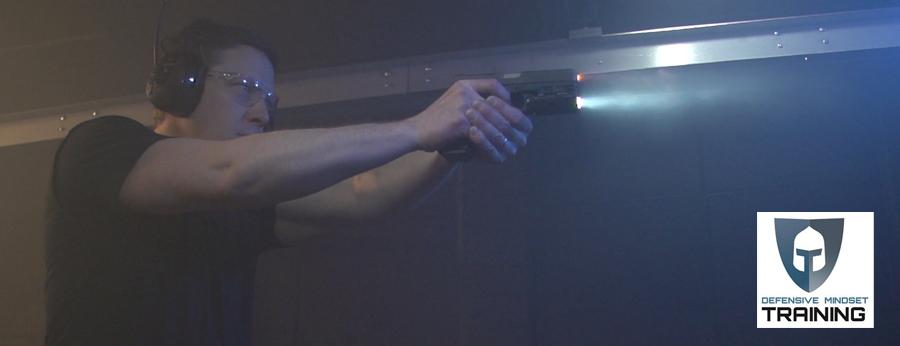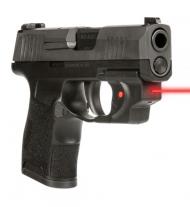Beau Doboszenski
Defensive Mindset Training
A consistent feature in defensive literature is the concept of “getting off the X.”
In military parlance, an ambush is set by creating two interlocking fields of fire from a unit. Those fields of fire interlock to make an ‘X.’ Therefore, to get out of an ambush, it is crucial to get out of that area of interlocking fire or “off the X.”
This concept has been more broadly applied to self-defense to mean getting off of the line of attack. In a one-on-one situation there isn’t an interlocking field of fire, but there is a point or line of attack. By picturing actual visual lines you gain an interesting perspective on how to deal with an incoming attack while moving and shooting.
At Defensive Mindset Training, we emphasize three possible choices in shooting and moving: Move to Shoot, Shooting on the Move, and Coverfire Movement. Each of these techniques is useful to practice not only for defensive use, but for sport use as well. Let’s go through how to use each one, and you can see them in the video at the end of this blog post.


1. Move to Shoot
Move to Shoot is where the shooter begins in position A, and then moves to position B as fast as possible. Once on position B, the shooter can engage the target. Defensively, this would be if the defender’s best option was to run to cover or concealment, getting off the ‘X’ and returning fire after getting to that superior defensive position. The key is moving quickly, then firing with accuracy from a new position.
The critical elements to practice are acceleration and deceleration. Once you recognize that it’s time to move, you need to MOVE. Practicing your reaction to stimulus is very important, and can be done with simple clapping drills from a random start shot timer, or three-step acceleration drills. But remember, starting to move is only half of this movement technique. Coming to a stop effectively is the other.
Deceleration is actually MORE physically taxing than acceleration and requires training to perform effectively. Developing the strength of your hamstrings, hip flexors, adductors, glute medius, and core will help your muscles absorb the deceleration energy of your body from full speed, and get your stop to be as quick and stable as possible.
In this scenario, there are four possible points wher eyou might deploy a firearm.
- Acceleration phase
The positive is that you’ll have your firearm right away. The negative is that you won’t be able to increase your movement to full speed as quickly because you’re focused on multiple things at once. - Top end phase, as you move at top speed
The positive is that the draw won’t interrupt your acceleration or deceleration; however, it will slow your running, since you won’t have the same effective arm swing as a normal sprint. - Deceleration phase
The positive is that you’ll have full speed from your acceleration to your deceleration and get there quickly. The drawback is that full speed deceleration takes a lot of body awareness and concentration, and adding one more skill to the movement - like a draw - only adds to the workload. - New position phase
If you wait to draw your weapon until you reach the new position, you’ll get there at maximum speed, but you will be significantly delayed in beginning your shots.

2. Shooting on the Move
The next technique is Shooting on the Move. This is a measured form of walking or striding that allows the shooter to place reasonably precise rounds on target. This is by far the most challenging of the three techniques. It is used most often in competitive shooting sports, but could reasonably be used in both citizen or law enforcement defensive encounters.
There are two challenging pieces to this technique that need to be practiced.
The first is the stride and shot rhythm. As we step, our bodies will have a slight wobble with each contact with the ground. That wobble can dramatically throw off our shots. This means that trigger presses must happen BETWEEN steps while the impact wobble is not present. As you can imagine, this timing feels really funky. If you’re suffering from other trigger errors like flinching, this can be exacerbated by having to be “forced” to shoot at a certain time, rather than simply applying slow steady pressure.
The second is turreting. The cannon of a tank is mounted to a revolving turret, allowing it to swing any direction, 360 degrees. Your upper body can move similarly, but only about 180 degrees. With Shooting on the Move, it’s critical to use this ability to turret so you can stride in almost any direction and engage in accurate fire. The simplest way to start to practice this skill is to stride laterally, left or right, in front of a target while shooting mid-stride. With practice, your stride pace can be sped up until it is almost a floating jog or run.
3. Coverfire Movement
The final movement type is Coverfire Movement. This is the most applicable for the Defender as our goal is primarily about speed rather than standard of accuracy. This is if you’ve been suddenly presented with a lethal threat to your safety and you need to get rounds on target immediately, not after you’ve moved to a new position. What’s important is the coordination of draw and movement simultaneously, as your first shot on target should be within a couple tenths of a second of your normal first shot on target time. So if normal is 1.4 seconds, 1.6 would be a good first time shot for Coverfire Movement.
Coverfire Movement is focused on the target’s center mass or center of face, and it’s important that you see your target in a non-linear way. That target isn’t just a flat piece of paper, but a cylinder of organs and blood vessels that can be punctured by rounds from any direction, 360 degrees around the target.
This movement skill is a combination of both speed and secondarily accuracy. You’re moving to get off the line like with the technique “Move then Shoot,” but you’re not waiting to get shots on target. And since this threat could be exceedingly close in a Coverfire scenario, from retention range to full presentation, you need to focus right away on getting out of the line of attack. This is why Coverfire Movement is less concerned with the extreme precision of “Shooting on the Move” technique. Coverfire Movement is moving fast and getting rounds on target with acceptable accuracy, as quickly as you possibly can to stop the threat.
For comparison: if in Shooting on the Move I get 3 shots off in a very tight 3 inch group in 3 seconds during my floating phase of my strides. In Coverfire Movement, I’d get off 6 shots in the same time period, in a 6 inch group across center mass or center of face. So more focus on speed, less focus on accuracy - although some level of accuracy is important, unless you want to imitate Hollywood movies and fire a dozen rounds while your target escapes unscathed.
Practicing these techniques will make your defense and competitive skills more effective. Remember to start training with dry fire using your SIRT before going live.





No Comments yet. be the first to comment.